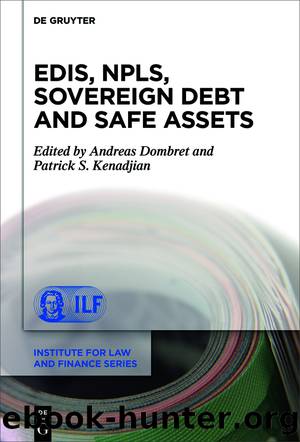EDIS, NPLs, Sovereign Debt and Safe Assets by Andreas Dombret Patrick S. Kenadjian

Author:Andreas Dombret, Patrick S. Kenadjian
Language: eng
Format: epub
Publisher: De Gruyter
Published: 2020-02-24T12:47:58.966000+00:00
Deposit Insurance on a European Level
In light of the aforementioned lack of a truly integrated financial market, still unsolved legacy risks related to, among others things, a high level of NPLs in the banksâ balance sheets and a need to further harmonise general private law, in particular insolvency law, the time for a European Deposit Protection Scheme has not yet come.
Irrespective of the specific EDIS proposal of the European Commission46, which shows substantial legal and technical deficits47, establishing a European deposit protection scheme requires a high degree of sensitivity. When it comes to EDIS, discussions areââ to a surprising extentââ emotionally driven. In particular, any form of a European deposit protection scheme is by some Member States automatically regarded as âgood for stabilityâ. However, whether a European Deposit Protection Scheme would in fact result in a higher degree of financial stability depends significantly on the specific design and the prerequisites that ensure a level playing field and sufficient and ongoing risk reduction.
Even if EDIS were to be restricted to a temporary liquidity assistance between national Deposit Guarantee Schemes (DGS), it still entails a sharing of risk. If funds are centralised or if DGSs would face cross-liability with other DGSs any depletion of such funds bears a contagion risk. A significant crises or bank failure in one Member State would drain liquidity from all DGSs and credit institutions due to ex-post contributions. In the EDIS proposal the maximum amount of ex-post contributions to be paid by credit institutions is not stipulated. Thus, credit institutions and DGSs alike could be struck by a sudden and significant liquidity outflow. Under the current EDIS proposal any potential depletion of funds related to a crisis in one Member State would mean that even small compensation cases in any other Member State could trigger bank runs and weaken financial stability. Under the current framework of the Deposit Guarantee Scheme Directive (DGSD) this contagion risk does not exist as funds are decentralised with a target level of 0.8â% of the covered deposits.
Therefore, it can only be welcomed that in December 2018 the Eurogroup agreed to set up a high-level working group (HLWG) to undertake technical preparation of a roadmap for starting political negotiations on a European Deposit Insurance Scheme (EDIS) and report to the European Council heads of state and government on its work. The HLWG focusses not only on possible designs of an EDIS but also on the Banking Union in general. Before a full assessment of the status quo and a clear common understanding of the Banking Union in its steady state is achieved, it will be impossible to establish any kind of EDIS, including a liquidity assistance system.
It is of utmost importance never to forget that EDIS should increase depositorsâ confidence in the protection of their deposits. Once this confidence is lost because of a premature introduction of EDIS, it will be extremely difficult to get back to todayâs level of trust.
Download
This site does not store any files on its server. We only index and link to content provided by other sites. Please contact the content providers to delete copyright contents if any and email us, we'll remove relevant links or contents immediately.
The Thirst by Nesbo Jo(6781)
Permanent Record by Edward Snowden(5707)
The Myth of the Strong Leader by Archie Brown(5391)
Spare by Prince Harry The Duke of Sussex(5027)
A Higher Loyalty: Truth, Lies, and Leadership by James Comey(4817)
Secrecy World by Jake Bernstein(4611)
Adulting by Kelly Williams Brown(4458)
The Borden Murders by Sarah Miller(4211)
Machine Learning at Scale with H2O by Gregory Keys | David Whiting(4033)
Killers of the Flower Moon by David Grann(3921)
American Kingpin by Nick Bilton(3731)
Fear by Bob Woodward(3609)
The Secret Barrister by The Secret Barrister(3589)
Future Crimes by Marc Goodman(3486)
The Last Girl by Nadia Murad(3414)
The House on Mango Street by Sandra Cisneros(3371)
Liar's Poker by Michael Lewis(3343)
The Social Psychology of Inequality by Unknown(2916)
Graduate Admissions Essays, Fourth Edition: Write Your Way into the Graduate School of Your Choice (Graduate Admissions Essays: Write Your Way Into the) by Asher Donald(2849)
